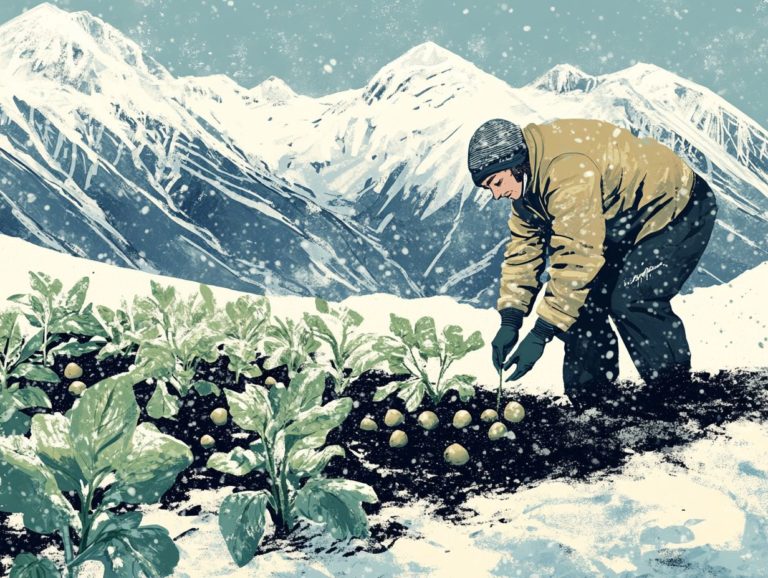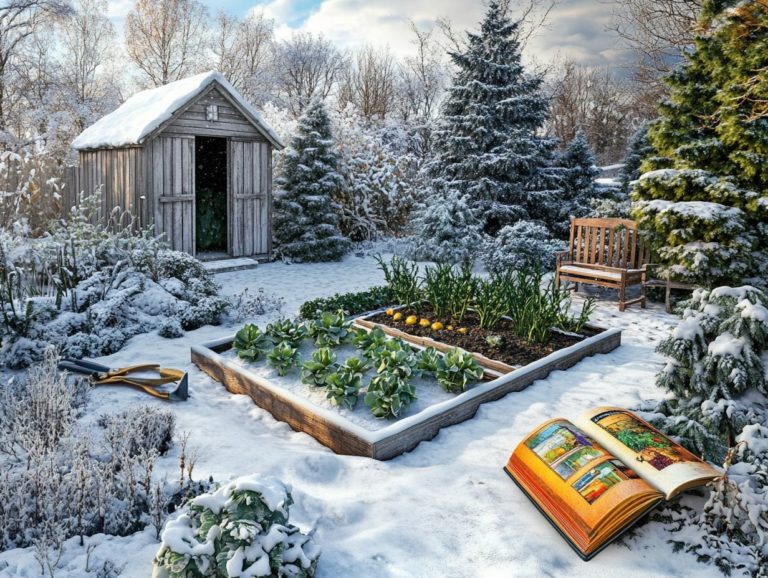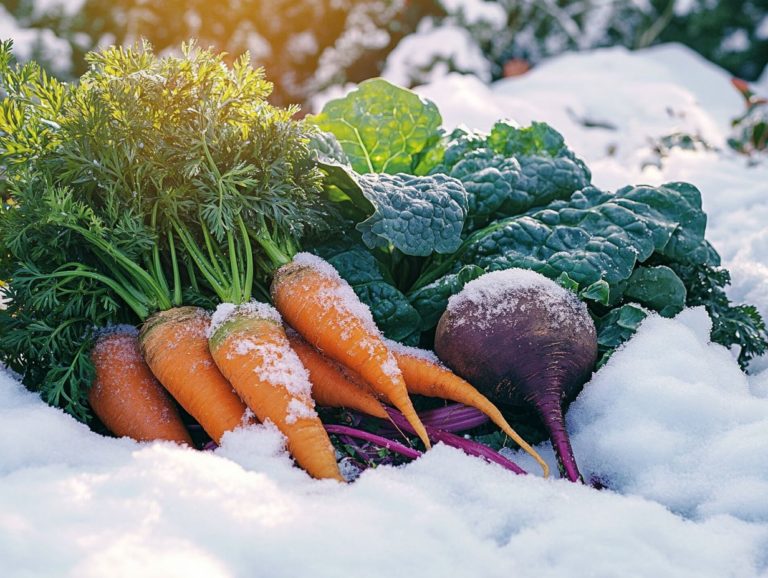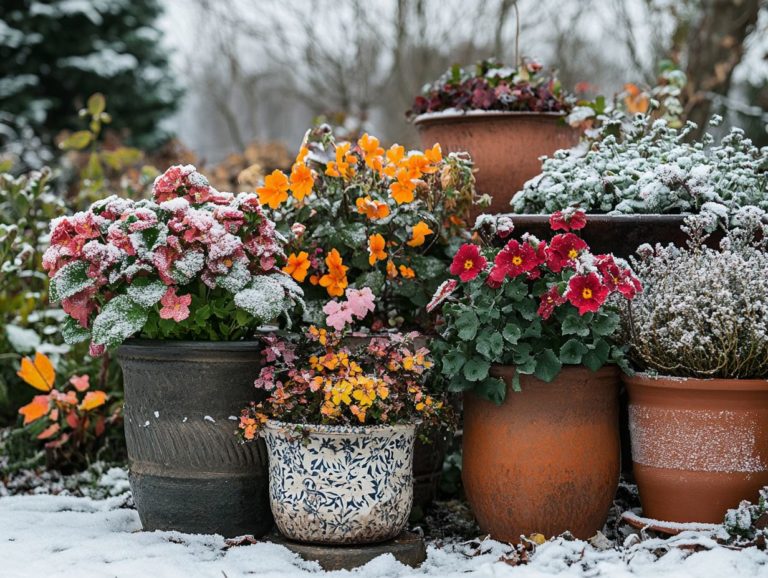What are the Symptoms of Frost Damage?
Frost damage has the potential to cause significant turmoil in your garden, particularly when temperatures take an unexpected plunge. By understanding what frost damage entails and recognizing its signs, you can take proactive measures to protect your beloved plants.
This guide will illuminate the symptoms of frost damage. You will learn about the visible effects on foliage and subtle changes in growth patterns.
It will also cover preventative strategies and best practices for gardening in cold weather. Additionally, effective treatments for any plants that may suffer will be discussed. Prepare yourself to safeguard your garden and bolster its resilience against those chilly nights.
Contents
Key Takeaways:
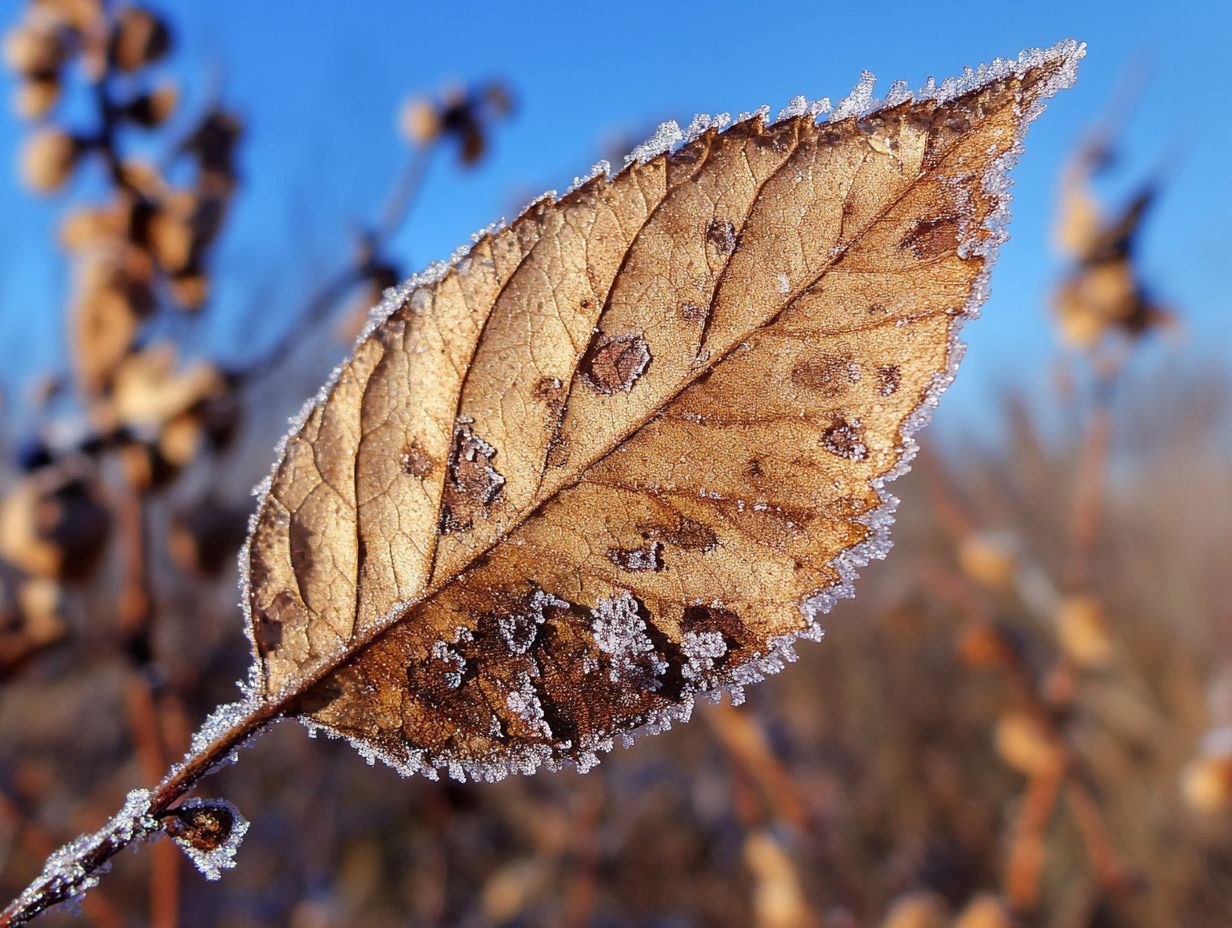
- Frost damage occurs when plants are exposed to freezing temperatures, causing harm to plant health.
- Visible signs of frost damage include wilting, discoloration, and damage to plant tissues. Changes in growth, such as stunted growth or delayed blooming, can also indicate frost damage.
- To prevent frost damage, take protective measures like covering plants or moving them indoors. Proper cold weather gardening practices can also help minimize the risk.
Understanding Frost Damage
Understanding frost damage is essential for any serious gardener or horticulturist. Chilly temperatures can pose significant risks to various plants, including flowers, vegetables, and evergreens.
Frostbite can harm plants at different growth stages. Young seedlings and herbaceous perennials are particularly at risk, resulting in noticeable signs of injury.
Familiarity with the USDA hardiness zones is key for you to ascertain which plants can endure frost exposure. These zones help you understand which plants can survive cold weather.
This knowledge enables you to implement effective care and maintenance strategies. Safeguarding vulnerable species will help cultivate a flourishing garden environment.
What is Frost Damage?
Frost damage occurs when your plants are exposed to cold temperatures. This exposure leads to frostbite that inflicts cellular injury and can potentially cause death in sensitive tissues.
This type of damage varies significantly among different plant classes. Annuals, for example, are particularly vulnerable. They complete their life cycle in a single growing season, so a late frost can devastate their growth and flowering potential.
Perennials, with their established root systems, might survive. However, they still risk stunted growth and reduced vigor if frost penetrates their tissues.
Bulbs have a fighting chance, as they may endure below the surface if properly insulated by soil. Yet frost can still interfere with their sprouting.
The underlying mechanism at play involves the formation of ice crystals within plant cells. This leads to ruptured membranes and loss of hydration.
This ultimately manifests as wilting, discoloration, or even the death of the affected parts.
Signs and Symptoms of Frost Damage
Identifying the signs and symptoms of frost damage is essential for effective treatment and prevention. Visible damage can present itself in various forms across different plant species, particularly in young leaves and shoots.
You may notice symptoms ranging from wilting and blackened leaves. Additionally, look for signs of stunted growth and overall decay, all of which signal that the plant’s health has been compromised by frost exposure.
Stay alert! Spotting these signs early can save your precious plants from further harm. Your vigilance is key to a thriving garden!
Visible Damage to Plants
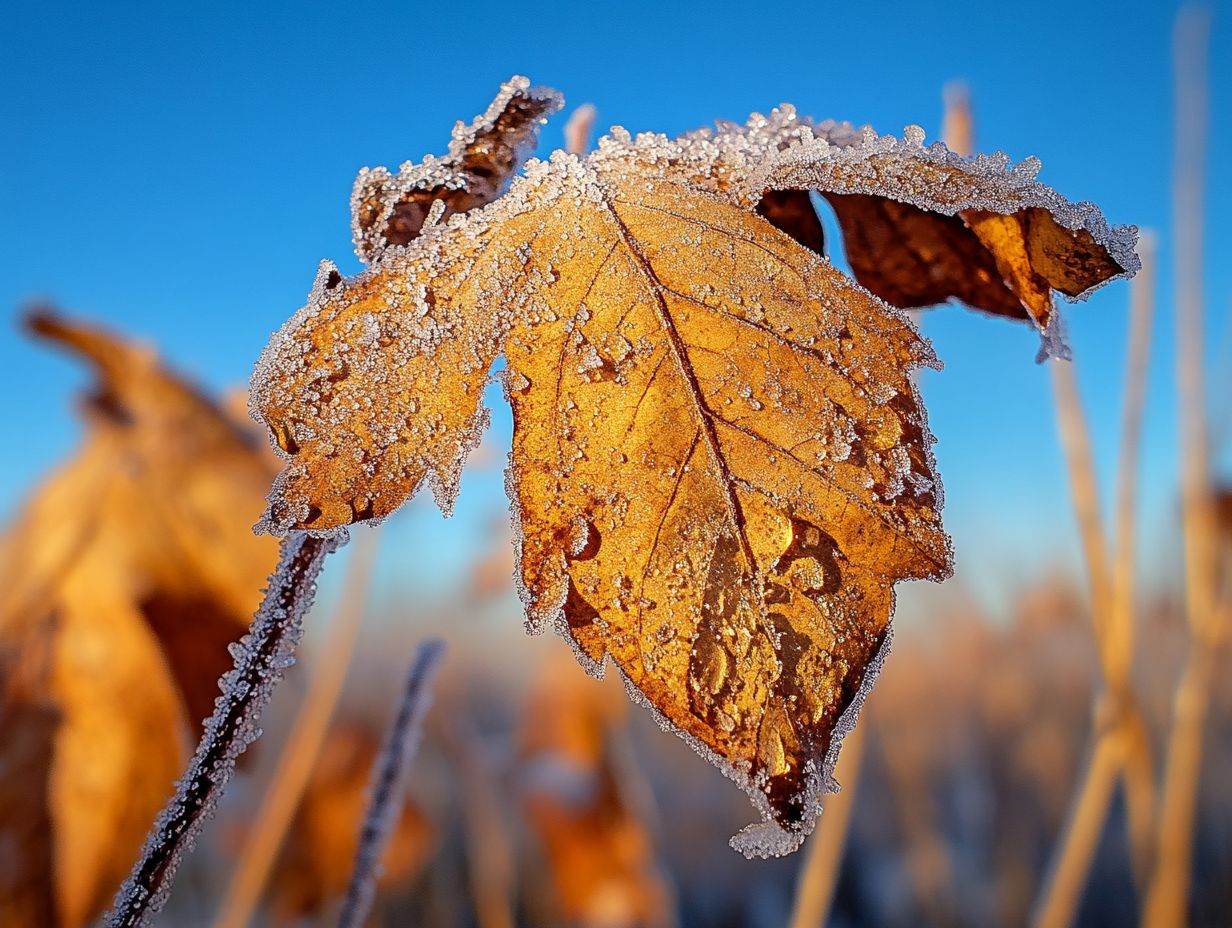
Visible damage from frost can be particularly alarming. Affected leaves may appear blackened or wilted, while shoots might show stunted growth or even dieback. This signals the detrimental impact of freezing temperatures.
This manifestation of frost damage varies significantly between herbaceous and woody plants. Herbaceous plants, often characterized by their soft, green tissues, tend to showcase rapid wilting and an overall droopy appearance. This can be distressing to observe.
In contrast, woody plants like trees and shrubs may not wilt immediately. Instead, they can display discolored leaves or experience a delayed dieback as the damage progresses internally. For instance, cranberries and peonies, which are herbaceous species, often reveal frost damage through visible browning and limp stems. Meanwhile, the buds and branches of a lilac or oak may turn dark and brittle, indicating significant injury.
Including photographs or illustrations can effectively highlight these variations. This helps you recognize the signs of frost damage across different plant types.
Changes in Plant Growth
Changes in plant growth following frost damage reveal the distress the plant has experienced, particularly in young specimens. You’ll likely notice slowed or halted growth due to frost exposure.
This vulnerability is especially pronounced in seedlings and new shoots, which are still establishing their root systems. When faced with unexpected cold snaps, these tender growths may suffer damage to the plant’s cells, resulting in discolored leaves, wilting, or even death.
There s good news for gardeners: many plants possess remarkable resilience. To help your plants recover, check the conditions and make sure they have enough water and shelter! With the right care, your plants can bounce back, showing fresh growth as temperatures stabilize. Just keep in mind that the timeline for recovery can vary widely depending on the species and the severity of the frost.
Preventing Frost Damage
Preventing frost damage is a proactive strategy. You need to implement protective measures and best practices for cold weather gardening to keep your plants safe from freezing temperatures.
By understanding your local climate and employing effective techniques such as mulching, covering, or relocating vulnerable plants, you can significantly minimize the risk of frost-related injury.
Recognizing the specific needs of various plant types be it perennials, vegetables, or annuals is crucial for effectively safeguarding them during harsh weather conditions.
Protective Measures for Plants
Implementing protective measures for your plants against frost is an essential practice every gardener should embrace. This involves techniques such as draping delicate specimens with cloths or plastic and applying mulch to insulate the soil.
Timing your protective actions is crucial. It s generally advisable to cover sensitive plants in the late afternoon before temperatures drop. This allows the covers to trap warmth from the ground effectively. For your annuals and tender perennials, lightweight fabrics offer breathability while providing a barrier against icy conditions.
A layer of organic mulch, like straw or wood chips, serves a dual purpose: it conserves soil warmth and reduces moisture loss, both of which are beneficial.
Don t wait! Apply mulch right after a rain to protect your plants. This enhances its insulating properties and ensures you don t smother the roots in the process.
Best Practices for Cold Weather Gardening

Adhering to best practices for cold weather gardening is crucial for the health and longevity of your plants. Strategies for frost protection come into play when temperatures drop.
These strategies shield vulnerable species from harsh conditions and contribute to a more resilient garden overall. By choosing cold-tolerant plants like pansies and kale, you can introduce vibrant color and nourishment to your winter landscape.
Preparing your site by improving soil drainage and adding mulch helps insulate roots and retain moisture. Regular care such as consistent watering and pest monitoring keeps your plants strong.
These collective efforts significantly enhance your plants’ ability to withstand frost and harsh temperatures, creating a thriving garden that not only survives but flourishes in the chill.
Dealing with Frost Damage
Dealing with frost damage requires immediate attention and a thoughtful approach. This minimizes further harm and promotes recovery in affected plants, allowing them to restore their health and vitality.
First, assess the extent of the damage to determine the right course of action. This may involve gently pruning the injured sections, rehydrating wilting stems, and providing proper soil care to support struggling roots.
By implementing effective management strategies, you can significantly enhance the recovery process for both young and established plants.
How to Treat Affected Plants
Treating your affected plants after frost damage requires a multi-step approach. Start by assessing the extent of the damage, which will guide you in implementing tailored treatment methods.
Watering is essential for maintaining soil moisture and preventing freeze damage. It helps rehydrate the plant and supports its recovery process. Don t overlook the importance of adequate mulching around the base, as this provides insulation and maintains soil moisture for hardy plants.
Targeted pruning, especially for deciduous varieties, is also vital. Removing dead or damaged foliage encourages new growth to emerge.
For sensitive flowering varieties, keep a watchful eye on environmental conditions, including humidity and soil moisture levels. Stay vigilant for signs of improvement, like new leaf growth or budding flowers. These are clear indicators that your plants are on the mend and ready to flourish once more.
Final Thoughts and Recommendations
Understanding frost damage and its implications for plant health is key for successful gardening. This knowledge enables you to make informed decisions that enhance the resilience of your green spaces during unpredictable cold spells.
By prioritizing prevention and implementing timely treatment strategies, you can reduce the risks associated with unexpected frost. Consider employing methods such as:
- Covering vulnerable plants, such as asparagus, strawberries, and blueberries, with frost blankets.
- Utilizing mulch to retain warmth and manage humidity.
- Strategically planting frost-resistant species, like daffodils and tulips.
These approaches will help safeguard your garden against damage. Keeping a watchful eye on weather forecasts and understanding USDA guidelines for frost zones prepares you for sudden temperature drops, enabling you to act quickly with protective measures.
With these proactive steps, you can cultivate a thriving garden rooted in knowledge about plant biology and chemistry. This garden will not only withstand the chill but also promote overall plant well-being.
Check out expert tips from Mary Ellen Ellis and Tonya Barnett for more gardening advice!
Frequently Asked Questions
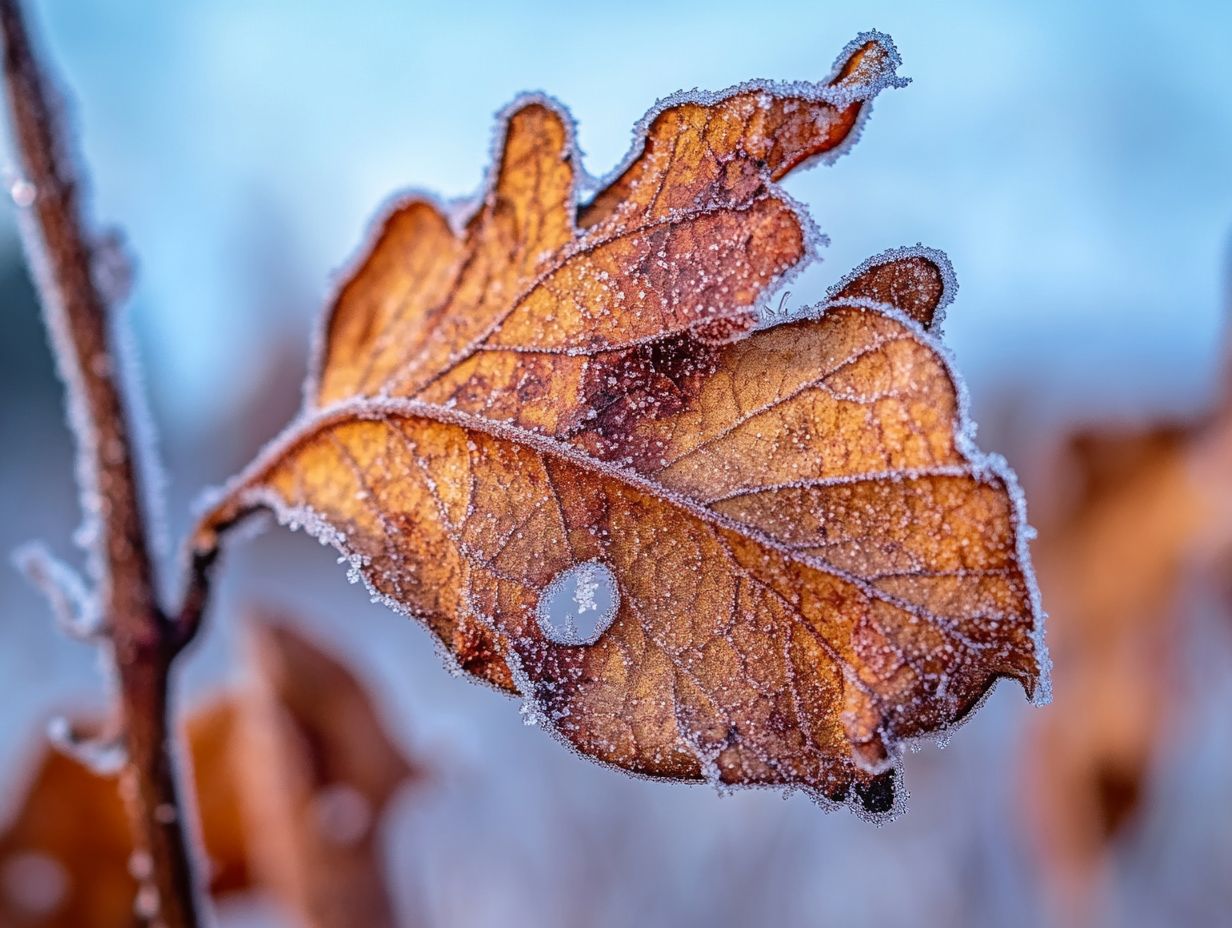
What are the Symptoms of Frost Damage?
Frost damage leads to symptoms like wilting, discoloration, and stunted growth.
These signs indicate when you should take action.
How can I tell if my plants have been affected by frost damage?
Plants affected by frost damage may appear droopy or wilted.
Look for curled or discolored leaves as well.
Are there any early warning signs of frost damage?
Yes, early signs include darkening leaves.
This can occur before more severe symptoms appear.
Can frost damage be fatal to plants?
In severe cases, frost damage can kill plants.
This is especially true if the roots are affected or if the plants are not hardy.
Are certain plants more susceptible to frost damage than others?
Yes, some plants are more vulnerable.
Tropical or tender plants, which cannot tolerate cold temperatures, are particularly at risk.
How can I protect my plants from frost damage?
Act now to shield your plants from frost damage!
Cover them with blankets or sheets today.
Water the soil thoroughly before a frost and bring potted plants indoors.

